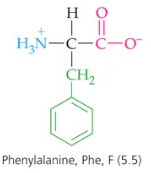 Back
BackProblem 1a
Decide whether each of the following statements is true or false. If false, explain why.
a. The amino acid pool is found mainly in the liver.
Problem 2
Serotonin is a monoamine neurotransmitter. It is formed in the body from the amino acid tryptophan. What class of enzyme catalyzes each of the two steps that convert tryptophan to serotonin?
Problem 3
What is the structure of the α-keto acid formed by transamination of the amino acid phenylalanine (Phe)?
Problem 6
Unlike most amino acids, branched-chain amino acids are broken down in tissues other than the liver. Using Table 18.3, identify the three amino acids with branched-chain R groups. For any one of these amino acids, write the equation for its transamination.
<IMAGE>
Problem 8
Fumarate from step 3 of the urea cycle may be recycled into aspartate for use in step 2 of the cycle. The sequence of reactions for this process is
a.
b.
c.
Classify each reaction as one of the following:
1. Oxidation
2. Reduction
3. Transamination
4. Elimination
5. Addition
Problem 14
Three metabolites that can result from the breakdown of the carbon skeleton of amino acids are ketone bodies, acetyl-CoA, and glucose. Briefly describe how each of these metabolites can be produced from amino acid catabolism.
Problem 15
Define what an “essential” nutrient is and explain how it differs from a “nonessential” nutrient.
Problem 16
In the liver, the relative activity of ornithine transcarbamylase is high, that of argininosuccinate synthetase is low, and that of arginase is high. Why is it important that ornithine transcarbamylase activity be high in the liver? What might be the consequence if arginase activity is low or defective?
Problem 20
What citric acid cycle intermediates are precursors to amino acids?
Problem 23a
What is the structure of the ⍺-keto acid formed from transamination of the following amino acids?
a. Glutamic acid
Problem 25
In general, how does oxidative deamination differ from transamination?
Problem 27a
Write the structure of the ⍺-keto acid produced by oxidative deamination of the following amino acids:
<IMAGE>
a. Leucine
Problem 28
What other product is formed in oxidative deamination besides an ⍺-keto acid?
Problem 31
Why does the body convert NH4+ to urea for excretion?
Problem 33
From what two amino acids do the nitrogens in urea arise?
<IMAGE>
Problem 37
If you were diagnosed as having a diet low in lysine, what foods might you include in your diet to alleviate this problem?
Problem 40
Diet soft drinks that are sweetened with aspartame carry a warning label for phenylketonurics. Why?
Problem 41
Which of the following biomolecules contain nitrogen?
a. Glycogen
b. Nitric oxide
c. Collagen
d. Epinephrine
e. Stearic acid
f. Fructose
Problem 44a
Name the four compounds within the citric acid cycle that the carbon skeletons of the glucogenic amino acid enter as.
Problem 45
Can an amino acid be both glucogenic and ketogenic? Explain why or why not.
Problem 50
The pancreatic proteases are synthesized and stored as zymogens. They are activated after the pancreatic juices enter the small intestine. Why is it essential that these enzymes be synthesized and stored in their inactive forms?
Problem 52
The net reaction for the urea cycle shows that three ATPs are hydrolyzed; however, the total energy “cost” is four ATPs. Explain why this is true.
Problem 53
Why might it be a bad idea to take large quantities of a single amino acid dietary supplement?
Problem 56
Determine how many ATPs you would make if you consumed a tetrapeptide comprised of leucine, histidine, valine, and lysine. Have each member of your group take one of the four amino acids and determine the number of ATPs their amino acid would make and combine them to get the total.





